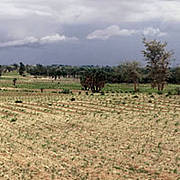The Ardvaark’s Happy Return
19 August 2008 | News story
The ardvaark was one of the first, but other species of bird and animal have since returned to a once bare and desolate corner of Tigray in northern Ethiopia.
Decades of farmer neglect in an already harsh environment had left the land devastated by soil erosion and desertification, barely able to sustain life of any kind, whether human or animal.
But a dramatic transformation has taken place since a special venture was launched – the Tigray Project – to rehabilitate land using an ecological and community based approach that employs sustainable cultivation methods to get the best out of local resources and farmers’ knowledge.
With the support of government agencies, the Institute for Sustainable Development (ISD), an Ethiopian non-governmental organisation (NGO), has worked for over a decade with farming communities to improve water and soil conservation, control previously rampant free range grazing and, crucially, to restore soil fertility through making and using compost.
“It was devastated, bare and windswept. It was basically neglect. In the 1990s, the farmers had no capital, nothing to buy anything with. Ethiopia had the lowest per capita use of chemical fertiliser in the world,” said the ISD’s Sue Edwards.
Initially covering just four pilot farming groups, the project has broadened out to over 60 local communities, involving hundreds of farming families.
The result has been higher yields, higher groundwater levels, better soil fertility, increased household income and a better life for women, who, as elsewhere in Africa, do much of the farm work.
Around Adi Nifas, which means “place of wind,” some 40 families taking part in the local project are able to get two crops a year from land once considered amongst the worst in the area.
“All the families have benefited from the rehabilitation by becoming food secure for at least 12 months,” said Edwards.
The story of this corner of Tigray prior to the project is the tale of much of sub-Saharan Africa, where the effects of climate change threaten to exacerbate the already debilitating impact of under-investment and poverty-led neglect.
Already degraded
Two thirds of sub-Saharan Africa is desert or drylands, which are areas characterised by a highly seasonal, unpredictable rainfall, water scarcity and a hot climate. Between 10 and 20 percent of the drylands are already degraded by erosion or salinisation.
Agriculture accounts for an average of 32 percent of the continent’s economic output, but sub-Saharan Africa’s overall per capita farm yields have been declining. In 2005, output per capita was 3 percent less than in 2000 and 12 per cent below 1975, according to various international agencies.
Thirty percent of Africans are chronically hungry, and there are similar levels of malnutrition among children under five. With the population certain to increase sharply in coming decades, poverty will grow.
Climate change will make thing worse. According to the United Nations Intergovernmental Panel on Climate Change (IPCC), farm yields could fall over 50 percent by 2020 due to an increasingly hotter and drier climate.
On top of this has come the current global food crisis which has seen staple food price rises of up to 80% in some countries around the world, and which will increase the misery for African countries dependent on imports.
Food supply is now Africa’s most “pressing challenge,” former United Nations Secretary-General Kofi Annan said recently.
"We need action to tackle the immediate food crisis in Africa and the long-term impact that climate change will have on food supplies and agriculture across the continent,” Annan added.
The food crisis and sustainable development will be central issues for a major environmental conference, the IUCN World Conservation Congress, being held October 5-14 in Barcelona, Spain, which brings together governments, non-governmental organisations and individual scientists.
The four-yearly congress of the International Union for Conservation of Nature (IUCN), the world’s oldest and largest environmental network,
will launch a special ‘Drylands and Desertification Strategy’ and a ‘Drylands and Livelihoods Initiative’ to guide work on developing sustainable and viable solutions for these environmentally highly vulnerable areas.
“With global challenges such as climate change, energy and food security, understanding, maintaining and restoring dryland ecosystem services will be critical,” the IUCN says in a document prepared for the congress.
Green revolution
The fear is that the continuing degradation of land will lead to more conflicts both within countries and between them as competition intensifies for the use of dwindling resources.
The brutal violence in the western Darfur region of Sudan, which was partly triggered by land disputes between farmers and nomads, is cited as an example of what could happen elsewhere.
For Annan, Africa’s farming urgently requires a “green revolution”. The Ghanaian was recently named chairman of the Nairobi-based ‘Alliance for a Green Revolution in Africa’, which is backed by the Rockerfeller and Bill and Melinda Gates foundations.
But Caterina Wolfangel, IUCN Programme Officer for Drylands, East and Southern Africa, cautions that past attempts at green revolutions have failed to trigger significant improvements in Africa.
Efforts in the 1970s, for example, to increase yields through a highly mechanized approach to agriculture, which were highly successful in Asia, got nowhere in Africa.
This was mainly because drylands require a different approach that is more adapted to their bio-climatic and socio-economic conditions, the IUCN expert explained.
“Drylands are areas characterized by a highly seasonal, unpredictable rainfall, water scarcity and a hot climate. Most development interventions have failed to take this into consideration, resulting in unsustainable land management and degradation of critical resources such as water, vegetation cover and soil fertility,” said Wolfangel.
In parts of the Sahel and other dry zones, farmers sought to produce more by increasing the area they cultivate rather than by improving yields on a sustainable basis on land already under cultivation. Given the marginal nature of the land and the fragility of the soil, this simply increased the problems.
But Wolfangel rejects the “gloom and doom” view of drylands agriculture, saying that drylands are already contributing significantly to livelihoods and national economies and have good potential to further sustainable development provided the rights steps are taken.
“Conservation and development must go hand in hand,” she said, adding that it was important to overcome the perception that drylands were “wastelands” and therefore unworthy of significant public investment.
There are signs that the international community is taking heed and is looking beyond a simplistic, “one size fits all” approach to take fuller account of local conditions and knowledge. Annan has stressed the need for sustainability.
New approach
The recently released International Assessment of Agricultural Science and Technology for Development, a 2,500-page report commissioned by the World Bank and the UN’s Food and Agriculture Organisation (FAO), concluded that future initiatives had to respect the “multiple functions of agriculture.”
They should embrace the “improvement of livelihoods, the enhancement of environmental services, the conservation of natural resources and biodiversity, and the contribution of agriculture to the maintenance of social and cultural traditions.”
“Science and technology should be targeted towards raising yields but also protecting soils, water and forests,” the authors wrote.
The FAO and others have suggested that ways should be found to put an economic value on local ecosystems so that farmers could be paid for their conservation role, thereby giving them a financial incentive to use resources in a sustainable way.
With its toolbox of low-tech solutions, the Tigray project could offer valuable lessons to others about the route to take, despite its relatively small size.
“I don’t think that Adi Nifas is unique. Its success shows what all small communities can do if they get together and decide to protect their environment and support each other. The situation in much larger areas could be quickly and radically improved,” Sue Edwards said.






